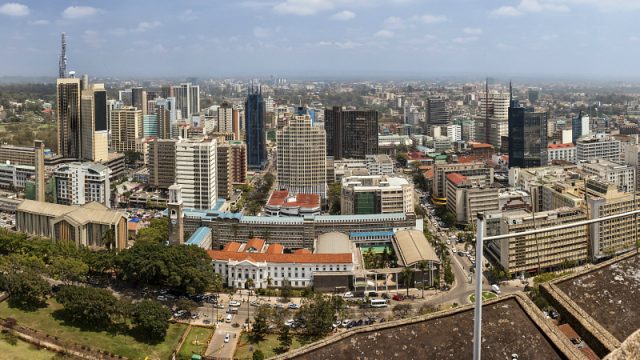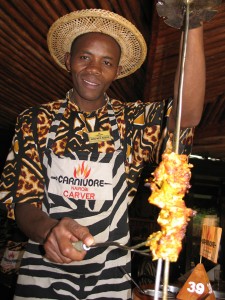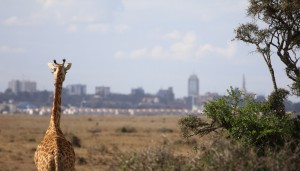Nairobi is one of the most exciting and cosmopolitan cities in Africa. From the glittery high-rises of the hectic CBD, to the swank northern suburbs, to the gritty neighborhoods that ring the city, you’ll find thousands of opportunities to shop, dine, and get immersed in local culture in establishments that reflect the international melting pot that is Nairobi.
History and Orientation
It’s hard to believe when you look around at the number of people and buildings in Nairobi, that this is an “accidental” city not much more than 100 years old. Instead of beginning as an ancient settlement or as a market town on a historic trade route, Nairobi started as a work camp at Mile 237 of the Mombasa-to-Kampala railroad around 1899. Since then, it has grown into one of the most exciting, cosmopolitan cities in Africa.
Nairobi is adjacent to Kenya’s famous Rift Valley and the Ngong Hills, and it’s also extremely close to Mount Kenya to the north, and Mount Kilimanjaro to the southeast — you can see both mountains from downtown on a clear day. Once you’re in the city’s CBD, it’s fairly easy to navigate and get your bearings, and most hotels can provide easy information for getting around foot or by taxi.
Attractions
Culture vultures can find more concerts, art exhibits, and museums than you can shake a stick at in Nairobi. Those seeking history, art and culture will want to stop by the Nairobi National Museum, a long-standing fixture in Nairobi. Aside from the cultural exhibits that offer a peek into African art, the Louis Leakey auditorium hosts a number of visual arts and musical shows — plus art workshops that will enthrall and move you. The National Museums of Kenya, in conjunction with Nairobi County, also provide for walking tours of the city, showcasing Nairobi’s rich heritage through her landmark buildings or monuments and the stories they have to tell.
The Murumbi collection is also a great place to check out and is comprised of artifacts and texts donated from the personal collection of the late Joseph Murumbi, former Vice President and curator of African heritage. This vast and enlightening collection is split between The Nairobi Gallery and the National Archives, both within the city centre. If you value an intimate look at Kenyan culture and history, both of these should make your top three list.
Synonymous with Kenya after she wrote Out of Africa, many parts of Karen Blixen’s life are featured in the Karen Blixen Museum. The house was once the centre of the farm owned by Blixen and her Swedish husband, Baron von Blixen. The museum itself is part of the Kenya National Museum. The house is set within a tranquil garden, and has a view of the Ngong Hills, so beloved by Karen. Also in Karen is the world-famous Kazuri Beads factory, which produces exquisitely handmade ceramic beads and pottery. It was founded by a European expat in 1975 to help provide livelihoods for poor single mothers.
Accommodation
Visitors to Nairobi have plenty of choices ranging from upmarket boutique hotels to shoestring budget options. One of the nicest places to rest your head is the Nairobi Serena Hotel. The hotel is an oasis of calm just outside the city center, separated from downtown by Central Park. It’s surrounded by lush tropical gardens with jacaranda, acacia trees and the riotous color of bougainvillea blossoms. This is a classic, upscale Western-style hotel, with all the expected services and amenities including free WiFi, a business center, fitness center, swimming pool, hair salon and spa. And because it’s located outside the city center, there’s free parking.
Another fantastic option is one of the most historic hotels in the city, the Sarova Stanley. Many famous people such as Ernest Hemingway and Frank Sinatra have graced this place over the years. The moment you pass through the century-old revolving doors, you enter another world: the hassle of the modern gives way to cool, almost stuffy, Victorian elegance. The woodwork is dark, the color scheme trending toward maroon and gold. There’s in-room Wi-Fi, a fully-equipped business center, a heated pool and a health club with gym, steam, sauna and massage facilities.
And just outside the city in the leafy suburb of Karen, you’ll find the lavish Hemingways Nairobi. The hotel feels a million miles away from the hustle and bustle of the city and is great if you are there for vacation instead of business. The 45-room boutique hotel is spread out on manicured lawns surrounded by horse farms and trees, so it feels more like a country escape than a city hotel. Everything about the hotel is top notch, from the polished and professional staff to the excellent food and the spa.
If you’re traveling on a budget, one of the cheapest options in the city is Wildebeest Eco Camp. It provides dorm rooms for a mere US$10 per night, or you can bring your own tent for only US$5-10 per night if you like to rough it. Another bargain option is the Kenya Youth Hostel. You can get dorm beds (in shared rooms with a communal bathroom) for just US$6-10 per night.
Dining
Diners heading to Nairobi have plenty of options for great Kenyan and international cuisine without breaking the bank. Much of the cuisine in Kenya revolves around large chunks of meat, and there’s no better place to get it than Carnivore. This Nairobi restaurant renowned for its wide selection of meat that’s sliced and served tableside. Although you won’t be offered elephant or giraffe, there’ll probably be crocodile and ostrich (and a dozen more meats) on offer. Everything is roasted on traditional Maasai swords over a huge charcoal pit that dominates the entrance of the restaurant.
For something a bit more elegant, stop in for lunch in the Thorn Tree Café at the Sarova Stanley Hotel. Although the original thorn tree is no more, its replacement still serves as a message board. The original was called Nairobi’s first post office, because in the city’s early days, residents would leave letters for friends pinned to its bark. The menu is extensive enough to offer something for everyone. As is true in most upscale hotels, the prices are a bit higher than in other restaurants, but you can’t beat the atmosphere.
And if you’re looking for great seafood, it’s hard to beat Tamarind. The restaurant flies it in fresh daily from Kenya’s Indian Ocean coast: prawns, crabs, lobsters, calamari, octopus and oysters are usually on the menu. Of course, steak and poultry also are on offer, but that’s not the reason to make a reservation at this decidedly upscale restaurant with attentive yet unobtrusive service in an elegant (albeit dated) décor in muted tones of beige, brown and gold with lots of mirrors to reflect the candlelight. Dining here is among the more expensive options in Nairobi. Expect to spend at least 3,000 KES for dinner. The Tamarind Nairobi is open for lunch and dinner Monday through Saturday, and for dinner on Sunday. If you don’t have a reservation, go early. The place doesn’t get busy until 9 p.m.
For nightlife, most tourists stick around the hotel bar’s like the Exchange at the Sarova Stanley, but there are several other places around the city to explore. Those looking for a more sophisticated scene might want to check out the Mercury Lounge, the club is well decorated and is popular for expats. Another cool place to checkout is the Brew Bistro, the outdoor terrace is a great place to go on busy nights when the crowd gets large and lively. There’s also usually a band performing or a DJ spinning popular tunes.
Shopping
Nairobi features many open-air shopping centers within the central business district that sell beaded items, arts and crafts, jewelry, carved goods, wall hangings and much more. Shoppers can find numerous ways to spend their cash, from the trinkets at the Maasai market, to the handmade beads at the Kazuri Beads factory, to the swank designer boutiques at Westgate Mall.
The Central Business District is geared more toward the clerks and officials who work there — think office supply stores, dry cleaners and banks — but there are a few places to indulge in a bit of retail therapy. It’s a good idea to do a bit of comparison shopping before loading up on souvenirs to bring home, and there are lots of African carvings, Maasai textiles and beaded necklaces from which to choose. Browse the storefronts along Biashara Street, check the art galleries on Kaunda and Standard streets, and consider the options at the Zanzibar Curio Shop on Moi Avenue, which has a good selection of traditional crafts at reasonable (and fixed) prices.
If you are out in Karen, the Kazuri Beads factory is a great place to stop and produces exquisitely handmade ceramic beads and pottery. It was founded by a European ex-pat in 1975 to help provide livelihoods for poor single mothers. Two employees in a small workshop in an estate’s backyard have become more than 400 who work in a factory that ships products to 30 countries worldwide (including the United States).
And a visit to Nairobi wouldn’t be complete without the visiting the vibrant Maasai Market. Every Saturday and Sunday, Maasai artisans proudly display beads, African-printed fabric, sculptures, shoes, bags, jewelry, and other artwork.
For a shopping experience with less crowds, you could check out the affluent Westlands neighborhood, a few minutes’ drive northwest of downtown, where there are enough different curio shops and boutiques to completely fill up your goodie bag before heading home.
Excursions
Many people heading to Nairobi are going there exclusively for the excursions just outside the city. Within a half-dozen or so miles of downtown is the Nairobi National Park, a 44-square-mile preserve with lions, Cape buffalo, rhinos and gazelles (an estimated 80 species of large mammals) plus ostrich, egrets and hundreds more seasonal birds. The wildlife is most active at dawn and dusk, and this will be your best chance to see the elusive leopard (a nocturnal hunter). You’ll be able to see plenty of animals here without venturing far from the city, only you’ll have the Nairobi skyline as a backdrop and traffic noise as a distant hum.
Another cool place to check out for wildlife is the David Sheldrick Wildlife Trust. Here, you can watch the staff bottle-feed the two dozen pachyderm “toddlers,” most of whom were orphaned by ivory poachers (a continuing challenge in sub-Saharan Africa). To avoid overexposing the young elephants to humans, they’re only on view for one hour. Get there by 10:30 a.m., and you can get a good spot at the rope for the 11 a.m. to noon feeding. Usually an elephant or two will come close enough to the rope that you can rub its dry and dusty thick skin.
To see a more gentle giant, head to the Giraffe Center, operated by the African Fund for Endangered Wildlife, a breeding facility for the endangered Rothschilds, one of many subspecies of giraffe. Visitors can climb a tower to hand-feed food pellets at giraffe-height. The bravest hold the pellets between their lips and let the animals swipe the food away with their long, slippery tongues. It’s one of the best places to go outside of Nairobi, especially if you want your children to get up close and personal with animals.
Those looking to get a bit of exercise and a dose of the natural world can head to the Oloolua Forest Trail. The facility offers not only the nature trail, but also a waterfall, natural caves, a viewing tower, and the Institute of Primate Research. Located in the suburb of Karen, just southwest of the central business district, it’s a great place for a relaxing a half-day trips.
Getting There and Around
Most travelers coming into the city will fly in via Nairobi’s main airport, Jomo Kenyatta (JKIA). Many major airlines such as British Airways, Air France and Kenya Airways have regular flights. You can also enter the city by train — there are daily arrivals and departures at the Nairobi Railway Station from Mombasa and Kisumu. There are also several bus operators in Kenya that can get you reliably from city to city, though its best to book these through a tour company.
Once in the city, taxis in Nairobi are plentiful from both the CBD and airport, but they don’t operate on a metered system, so make sure you get a quote before getting in. Tuk-tuks are also available for intrepid travelers that want to save some money. Even more adventurous travelers can try a matatu (mini-bus). These operate on set routes and allow passengers to get on and off wherever they want. However, if you’re claustrophobic or don’t like speed you may want to avoid them, because they are often crowded and drivers don’t necessarily respect speed limits. Unless you’ve been to Kenya before and are familiar with the roads and know where you’re going, you probably don’t want to rent a car and self-drive.
Practical Considerations
Languages: English is one of the country’s two official languages (the other is Swahili). However, an estimated 60 different languages are spoken in Kenya.
Weather: Nairobi, because of its altitude, is cooler than the rest of Kenya, which can be quite hot. Especially in the evening, the city can get a bit chilly, so you’ll want to bring a light jacket or sweater. The climate is subtropical highland, experiencing highs around 25C (77F) December through March, and highs around 22C (72F) June through August. There are also two rainy seasons peaking in April-May, and again in November-December.
Health and Safety: The rules for avoiding petty theft are the same in Nairobi as they are anywhere else you might go in the third world. Be aware of your surroundings and don’t flaunt money or pricey possessions. During the day the touristed areas are OK to walk around in, but avoid them at night. Don’t walk on deserted beaches at any time.
Hospitals:
- Kenyatta National Hospital / 020 2726300
- Nairobi Hospital / 020 2845000
Emergency numbers:
- Police: 999
- Fire: 2222181/2
Money and banking: You’ll need Kenyan Shillings (KES) for most purchases in Nairobi. Although businesses catering to tourists (including hotels, resorts, restaurants and the larger souvenir shops) will usually take credit cards, cash is especially useful when bargaining with vendors or paying taxi drivers. You can easily get KES by going to an ATM or a wide number of banks in the CBD.
More information: Visit the Kenya Tourism Board.
Susan McKee contributed to this article.





